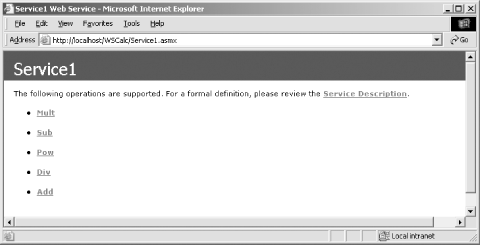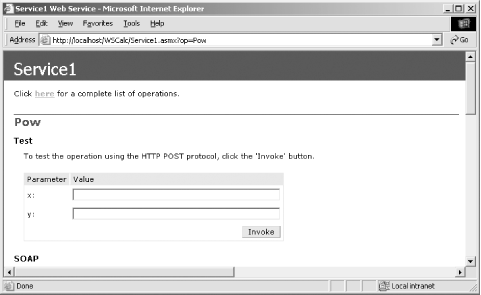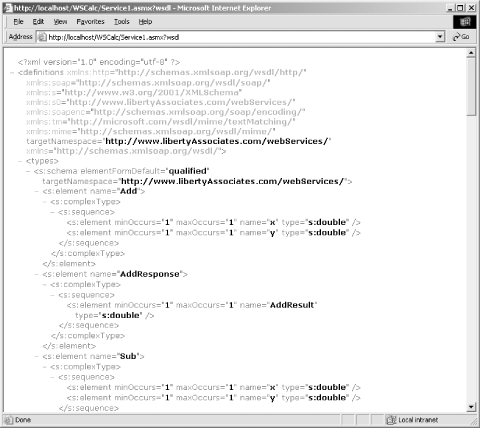| [ Team LiB ] |
|
15.8 Building a Web ServiceTo illustrate the techniques used to implement a web service in C# using the services classes of the .NET Framework, build a simple calculator and then make use of its functions over the Web. Begin by specifying the web service. To do so, define a class that inherits from System.Web.Services.WebService. The easiest way to create this class is to open Visual Studio and create a new C# Web Service project. The default name that Visual Studio provides is WebService1, but you might want to choose something more appropriate. Visual Studio .NET creates a skeleton web service and even provides a Web Service example method for you to replace with your own code, as shown in Example 15-4. Example 15-4. Skeleton web class generated by Visual Studio .NETusing System;
using System.Collections;
using System.ComponentModel;
using System.Data;
using System.Diagnostics;
using System.Web;
using System.Web.Services;
namespace WSCalc
{
/// <summary>
/// Summary description for Service1.
/// </summary>
public class Service1 : System.Web.Services.WebService
{
public Service1( )
{
//CODEGEN: This call is required by
// the ASP.NET Web Services Designer
InitializeComponent( );
}
#region Component Designer generated code
//Required by the Web Services Designer
private IContainer components = null;
/// <summary>
/// Required method for Designer support - do not modify
/// the contents of this method with the code editor.
/// </summary>
private void InitializeComponent( )
{
}
/// <summary>
/// Clean up any resources being used.
/// </summary>
protected override void Dispose( bool disposing )
{
if(disposing && components != null)
{
components.Dispose( );
}
base.Dispose(disposing);
}
#endregion
// WEB SERVICE EXAMPLE
// The HelloWorld( ) example service
// returns the string Hello World
// To build, uncomment the following lines
// then save and build the project
// To test this web service, press F5
// [WebMethod]
// public string HelloWorld( )
// {
// return "Hello World";
// }
}
}
Create five methods: Add( ) Sub( ), Mult( ), Div( ), and Pow( ). Each takes two parameters of type double, performs the requested operation, and then returns a value of the same type. For example, here is the code for raising a number to some specified power: public double Pow(double x, double y)
{
double retVal = x;
for (int i = 0;i < y-1;i++)
{
retVal *= x;
}
return retVal;
}
To expose each method as a web service, you simply add the [WebMethod] attribute before each method declaration: [WebMethod] You are not required to expose all the methods of your class as web services. You can pick and choose, adding the [WebMethod] attribute only to those methods you want to expose. That's all you need to do; .NET takes care of the rest.
Example 15-5 shows the complete source code for the calculator web service. Example 15-5. Calculator web service programusing System;
using System.Collections;
using System.ComponentModel;
using System.Data;
using System.Diagnostics;
using System.Web;
using System.Web.Services;
namespace WSCalc
{
[WebService(Namespace="http://www.libertyAssociates.com/webServices/")]
public class Service1 : System.Web.Services.WebService
{
public Service1( )
{
//CODEGEN: This call is required by the
//ASP.NET Web Services Designer
InitializeComponent( );
}
#region Component Designer generated code
//Required by the Web Services Designer
private IContainer components = null;
/// <summary>
/// Required method for Designer support - do not modify
/// the contents of this method with the code editor.
/// </summary>
private void InitializeComponent( )
{
}
/// <summary>
/// Clean up any resources being used.
/// </summary>
protected override void Dispose( bool disposing )
{
if(disposing && components != null)
{
components.Dispose( );
}
base.Dispose(disposing);
}
#endregion
[WebMethod]
public double Add(double x, double y)
{
return x+y;
}
[WebMethod]
public double Sub(double x, double y)
{
return x-y;
}
[WebMethod]
public double Mult(double x, double y)
{
return x*y;
}
[WebMethod]
public double Div(double x, double y)
{
return x/y;
}
[WebMethod]
public double Pow(double x, double y)
{
double retVal = x;
for (int i = 0;i < y-1;i++)
{
retVal *= x;
}
return retVal;
}
}
}
When you build this project with Visual Studio .NET, a DLL is created in the appropriate subdirectory of your Internet server (e.g., C:\InetPub\wwwroot\WSCalc). A quick check of that directory reveals that a .vsdisco file has also been added.
15.8.1 Testing Your Web ServiceIf you open a browser to your web service's URL (or invoke the browser by running the program in Visual Studio .NET), you get an automatically generated, server-side web page that describes the web service, as shown in Figure 15-7. Pages such as this offer a good way to test your web service. (The next section illuminates the seeming hocus-pocus that produces these pages.) Figure 15-7. The web service web page Clicking a method brings you to a page that describes the method and allows you to invoke it by typing in parameters and pressing the Invoke button. Figure 15-8 illustrates. Figure 15-8. Test page for a web service method If you type 3 into the first value field and 4 into the second field, you will have asked the web service to raise 3 to the fourth power. The result is an XML page describing the output, as shown in Figure 15-9. Figure 15-9. XML output for a web service method Notice that the URL encodes the parameters of 3 and 4, and the output XML shows the result of 81 (3*3*3*3 = 81). 15.8.2 Viewing the WSDL ContractA lot of work is being done for you automatically. HTML pages describing your web service and its methods are generated, and these pages include links to pages in which the methods can be tested. How is this done? As noted earlier, the web service is described in WSDL. You can see the WSDL document by appending ?WSDL to the web service URL, like this: http://localhost/WSCalc/Service1.asmx?wsdl The browser displays the WSDL document, as shown in Figure 15-10. Figure 15-10. Sample WSDL output for calculator web service The details of the WSDL document are beyond the scope of this book, but you can see that each method is fully described in a structured XML format. This is the information used by SOAP to allow the client browser to invoke your web service methods on the server. |
| [ Team LiB ] |
|